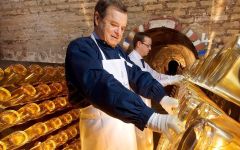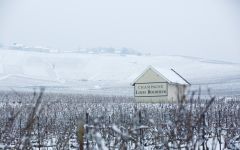Louis Roederer Blanc de Blancs 2002
-
Wine
Enthusiast -
Wine
Spectator -
Robert
Parker


Product Details
Your Rating
Somm Note
Winemaker Notes
On the palate, it is has a velvety attack, with rich, smooth texture, typical of Louis Roederer. Enhanced by soft effervescence, this great wine reveals a perfectly balanced structure, both creamy and aerial. It almost tickles the palate with clean, fine and precise texture, strengthened on the finish by the light bitter taste of fresh almonds, and the softness of ripe, lightly caramelized apples.
This Blanc de Blancs combines finesse and vinosity: it expresses with subtlety and refinement all the qualities of freshness, roundness and precision characteristic of the best Chardonnays in Champagne. Ideal as an aperitif, Blanc de Blancs also is the perfect accompaniment to seafood, fish and goat's cheese.
Professional Ratings
-
Wine Enthusiast
The purity of this wine is impressive. It has a straight line of mineral, flint and grapefruit running through it. Around this, there are layers of fresh apples, lime zest and a tight, taunt structure. Give it 4-5 years.
-
Wine Spectator
A weighty style, with emphasis on richness and power rather than elegance. That suits the peach, candied citrus and honey flavors, which linger nicely. The finish tightens up, so give this some time. Best from 2010 through 2025.
-
Robert Parker's Wine Advocate
The 2002 Brut Blanc de Blancs emerges from the glass with attractive notes of smokiness, ripe pears, flowers and spices. The wine shows excellent depth in a rich, generous style, with suggestions of minerality, toastiness and chalk that round out the finish.
Other Vintages
2016-
Wine
Enthusiast -
Wine &
Spirits -
Wine
Spectator
- Vinous
-
Jeb
Dunnuck
-
James
Suckling -
Robert
Parker -
Wine &
Spirits -
Wine
Spectator
-
James
Suckling -
Wine
Enthusiast -
Robert
Parker -
Wine
Spectator -
Wine &
Spirits
-
Wine &
Spirits -
Wine
Enthusiast -
James
Suckling -
Robert
Parker -
Wine
Spectator
-
Wine
Enthusiast -
Wine
Spectator -
Wine &
Spirits
-
Wine &
Spirits -
Wine
Enthusiast -
Wilfred
Wong
-
Wine &
Spirits -
Wine
Spectator
-
Robert
Parker -
Wine
Spectator
-
Wine &
Spirits -
Wine
Enthusiast
-
Wine &
Spirits -
Robert
Parker -
Wine
Enthusiast -
Wine
Spectator
-
Wine
Enthusiast -
Wine
Spectator
-
Robert
Parker
-
Wine &
Spirits -
Wine
Spectator
-
Robert
Parker
-
Wine &
Spirits






Uncompromising Quality
Champagne Louis Roederer was founded in 1776 in Reims, France and is one of the rare family owned companies, which is still managed by the Roederer family. In 1833, Louis Roederer inherited the company from his uncle and renamed the company under his namesake. Under his leadership, the company rapidly grew while remaining true to their philosophy of uncompromising quality. Today, the company is under the helm of Jean-Claude Rouzaud and his son Frédéric who continue to place quality before quantity.
First-Rate Vineyards
Champagne Louis Roederer is one of the only French champagne producers to own nearly 75 percent of the grapes in the most desirable vineyards in the Champagne. The property is located on 450 acres in the finest villages of Montagne de Reims, Côtes des Blancs, and Valleé de la Marne. Each region is selected to produce Chardonnay and Pinot Noir with the elegance needed for perfectly balanced champagne. The Louis Roederer vineyards rate an average 98 percent based on France’s statutory 100-point classification scale.
The reserve wine is then tasted and graded by a team of Roederer specialists. They choose as many as 40 different wines from several lots for the blend. For the final touch, the wine is then added in order to enhance the cuvee and guarantee consistency while retaining the champagne's characteristics.

Representing the topmost expression of a Champagne house, a vintage Champagne is one made from the produce of a single, superior harvest year. Vintage Champagnes account for a mere 5% of total Champagne production and are produced about three times in a decade. Champagne is typically made as a blend of multiple years in order to preserve the house style; these will have non-vintage, or simply, NV on the label. The term, "vintage," as it applies to all wine, simply means a single harvest year.

Associated with luxury, celebration, and romance, the region, Champagne, is home to the world’s most prized sparkling wine. In order to bear the label, ‘Champagne’, a sparkling wine must originate from this northeastern region of France—called Champagne—and adhere to strict quality standards. Made up of the three towns Reims, Épernay, and Aÿ, it was here that the traditional method of sparkling wine production was both invented and perfected, birthing a winemaking technique as well as a flavor profile that is now emulated worldwide.
Well-drained, limestone and chalky soil defines much of the region, which lend a mineral component to its wines. Champagne’s cold, continental climate promotes ample acidity in its grapes but weather differences from year to year can create significant variation between vintages. While vintage Champagnes are produced in exceptional years, non-vintage cuvées are produced annually from a blend of several years in order to produce Champagnes that maintain a consistent house style.
With nearly negligible exceptions, . These can be blended together or bottled as individual varietal Champagnes, depending on the final style of wine desired. Chardonnay, the only white variety, contributes freshness, elegance, lively acidity and notes of citrus, orchard fruit and white flowers. Pinot Noir and its relative Pinot Meunier, provide the backbone to many blends, adding structure, body and supple red fruit flavors. Wines with a large proportion of Pinot Meunier will be ready to drink earlier, while Pinot Noir contributes to longevity. Whether it is white or rosé, most Champagne is made from a blend of red and white grapes—and uniquely, rosé is often produce by blending together red and white wine. A Champagne made exclusively from Chardonnay will be labeled as ‘blanc de blancs,’ while ones comprised of only red grapes are called ‘blanc de noirs.’
